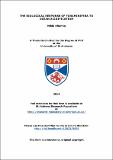Files in this item
The biological response of foraminifera to ocean acidification
Item metadata
| dc.contributor.advisor | Paterson, D. M. (David M.) | |
| dc.contributor.author | Khanna, Nikki | |
| dc.coverage.spatial | 272 | en_US |
| dc.date.accessioned | 2016-01-27T14:38:04Z | |
| dc.date.available | 2016-01-27T14:38:04Z | |
| dc.date.issued | 2014 | |
| dc.identifier.uri | https://hdl.handle.net/10023/8089 | |
| dc.description.abstract | Elevated atmospheric concentrations of carbon dioxide (CO₂), partly driven by anthropogenic activity, are decreasing the pH of the oceans. This thesis aimed to assess the biological response of foraminifera to ocean acidification. Foraminifera are single-celled organisms that form the dominant component of many marine communities. A series of laboratory experiments were carried out on benthic intertidal foraminifera from the Eden and Ythan estuaries, NE Scotland, to assess the impacts of ocean acidification. The responses of two dominant intertidal species of foraminifera (Haynesina germanica and Elphidium williamsoni) to ocean acidification were initially investigated in a short-term (6 week) experiment. Multiple species and multiple stressors (seasonal temperature regime and elevated CO₂) were then incorporated in a long-term (18 month) mesocosm study to investigate the physiological consequences (e.g. survival, growth) of ocean acidification. Survival of both Haynesina germanica and Elphidium williamsoni was significantly reduced under low pH conditions. Live specimens of both these calcareous species were however recorded at low pH, in reduced numbers. Following long-term exposure to ocean acidification, foraminiferal populations were still dominated by calcareous forms. Agglutinated foraminifera were recorded throughout the long-term incubations but their numbers were not high enough in the initial sediment collections to allow them to contribute significantly to the populations. Overall, survival of all foraminifera was greatly reduced in elevated CO₂ treatments. Temperature effects were observed on foraminiferal survival and diversity with the largest CO₂ effects recorded under the seasonally varying temperature regime. Foraminiferal test damage for all live species was also highest under elevated CO₂ conditions. Test dissolution was particularly evident in Haynesina germanica with important morphological features, such as functional ornamentation, becoming reduced or completely absent under elevated CO₂ conditions. A reduction in functionally important ornamentation could lead to a reduction in feeding efficiency with consequent impacts on this organism’s survival and fitness. In addition, changes in the relative abundance and activities of these important species could affect biological interactions (e.g. food web function) and habitat quality. | en_US |
| dc.language.iso | en | en_US |
| dc.publisher | University of St Andrews | |
| dc.subject.lcc | QL368.F6K5 | en_US |
| dc.subject.lcsh | Foraminifera--Effect of water pollution on | en_US |
| dc.subject.lcsh | Ocean acidification | en_US |
| dc.title | The biological response of foraminifera to ocean acidification | en_US |
| dc.type | Thesis | en_US |
| dc.type.qualificationlevel | Doctoral | en_US |
| dc.type.qualificationname | PhD Doctor of Philosophy | en_US |
| dc.publisher.institution | The University of St Andrews | en_US |
This item appears in the following Collection(s)
Items in the St Andrews Research Repository are protected by copyright, with all rights reserved, unless otherwise indicated.

